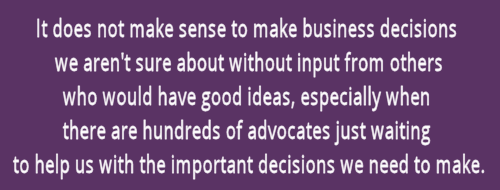In your pre-advocacy lifetime, you may never have thought you would be dealing with “customer service.” And yet, now that you’ve started working with clients, that’s what you’re required to do every time you interface with a customer (client) in any way: in-person, through phone calls, or email, or even postal mail. Your website represents customer service. Even the signature on your email is a form of customer service.
Most new business owners who have never before lived in a customer service world believe that all they need to do is listen and respond. But that’s really only a start.
Today we’re going to look at finding ways to provide customer service that provide an experience with you and your practice that may be expected, or may instead be totally UNexpected, or provide a delightful surprise.
Of course, in these posts I’m all about providing examples… Do as I DO and not just as I say! Here’s an example of how we, through the myAPHA membership website, provide that customer service in a way you might not have expected.
Cue the Search Meter
Whenever you need to find a piece of information, fast, there are two ways to do a search in the myAPHA.org membership site:
- One search bar is at the top and bottom of every page. Input here will search every article, podcast, post, blog post, etc., available to members.

- The other is a search of the Discussion Forums to find topics previously discussed.

Hundreds of searches take place on the site each month because our savviest members have realized that whatever needs to be found, is most quickly found by using the SEARCH function.
In most cases – maybe 99% – they find what they need and possibly MORE than they need.
But sometimes they don’t find what they are looking for!
Enter APHA customer (member!) service:
What most members don’t know, and may find to be a delightful surprise, is that we track those searches to be sure we are providing material and information our members want and need, as long as it’s appropriate to provide it.
So we track all searches with the Search Meter* It’s a useful little tool that works behind the scenes to tell us what our members are looking for. When we review the data, we know what needs to be added to the site.
How do we do that? Let’s begin by looking at the Search Meter results available today – here’s a screenshot:

The results fall into two categories:
1. The ones we ignore (circled in red):? These are misspellings, or squashedspellings, or some topic that just doesn’t need to be addressed on a site that supports health and patient advocacy and care management professionals. Also in the “ignored” category are those names of members who have (probably) searched for themselves. 
2. The ones we do something about (circled in blue-purple). This is where that customer service label comes in. Surprise! When we find a search has been done for an important or interesting topic, but there aren’t enough results (only 0 or 1), then, as it makes sense, we add that information to the site. We do this because we believe that if one person wants to know, someone else will want to know again someday, too.
So what was our response to these Search Meter results? Two new articles:
- In response to CEUs, we published a new article entitled Earning Continuing Education Credits (CEs or CEUs) which helps members understand how they can use their membership to fulfill certification continuing education requirements.
- In response to “Monday Member Mail” we published a new article entitled Keeping Up with the Search Meter. We’ll continue to add to this article when there is a random search such as the one for Monday Member Mail. Now, if someone searches again for “Monday Member Mail” – they will find a result. (What IS Monday Member Mail? Check out the article!)
There is only one problem we run into by using this Search Meter. That is, we don’t know who did the search that showed up in the Search Member, so we can’t go back to the members who did the searches (and didn’t get the results needed) to tell them we now have information available for them. But, in some ways, that’s a good thing.*
So there is the example promised – a way of serving customers / clients in a way they might not expect, resulting in improved customer service for everyone.
Have you developed tactics for your clients that you would be willing to share with others?
…..
*A member once told me it was creepy to be tracked. To put your mind at ease, the ONLY thing the Search Meter tracks – as you can see above – is the actual term from the search and how many times that search was conducted, plus how many result links were available. It doesn’t track WHO looked, not even WHEN they looked. You can see that each is a link… it links to the search results for that term, and nothing else.
LEARN ABOUT APHA MEMBERSHIP | MASTER LIST OF PRACTICE RESOURCES | ONLINE COURSES TO LEARN ADVOCACY





